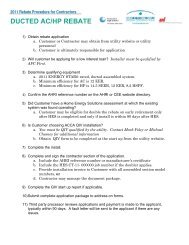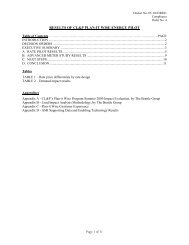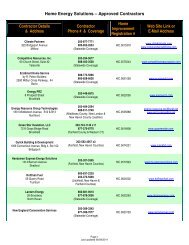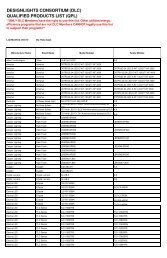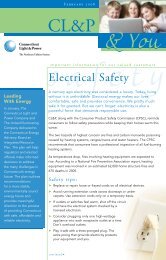Opinion - Northeast Utilities
Opinion - Northeast Utilities
Opinion - Northeast Utilities
Create successful ePaper yourself
Turn your PDF publications into a flip-book with our unique Google optimized e-Paper software.
Docket No. 424 - Interstate<br />
<strong>Opinion</strong><br />
Page 12<br />
Substations/Switching Station<br />
Since the proposed modifications to the substations do not go outside the existing fence lines, the Council expects<br />
no adverse environmental impacts.<br />
Three wetlands exist on the Card Street Substation property, 100 feet outside the existing fence line; however,<br />
effects to those wetlands would be minimized by the installation of erosion and sedimentation controls.<br />
Two state-listed moth species were known to occur near Lake Road Switching Station; however, at a distance that<br />
prevents any adverse impacts.<br />
Killingly Substation is located in an area that may contain state-listed invertebrate species of moths and<br />
butterflies, and CL&P consultants observed these species during field surveys of the ROWs; however, the<br />
substation itself would not be suitable habitat for these species. Killingly Substation is also in the vicinity of the<br />
Tracy Road Trail, which is a one-mile paved walking/biking trail; however, intervening vegetation and<br />
topography screen the substation from the trail.<br />
Considering that no new substations are being constructed and that construction activities at all the substations<br />
will go on inside the fence line, the Council judges that the substations will have minimal environmental effect.<br />
VI. Electric and Magnetic Fields<br />
The Council’s “Electric and Magnetic Field Best Management Practices for the Construction of Electric<br />
Transmission Lines in Connecticut” (EMF BMPs) were revised in December 2007 to address concerns regarding<br />
potential health risks from exposure to EMF from transmission lines. The Council’s EMF BMPs support the use<br />
of effective no-cost and low-cost technologies and management techniques to reduce magnetic fields (MF)<br />
exposure to the public while allowing for the development of electric transmission line projects.<br />
International health and safety agencies, including the World Health Organization (WHO), the International<br />
Agency for Research on Cancer (IARC), and the International Commission on Non-Ionizing Radiation Protection<br />
(ICNIRP), have studied the scientific evidence regarding possible health effects from MF produced by nonionizing,<br />
low-frequency (60-Hertz (Hz)) alternating currents in transmission lines. Two of these agencies have<br />
attempted to advise on quantitative guidelines for mG limits protective of health, but have been able to do so only<br />
by extrapolation from research not directly related to health: by this method, the maximum exposure advised by<br />
the International Committee on Electromagnetic Safety (part of IARC) is 9,040 mG, and the maximum exposure<br />
advised by the ICNIRP is 2,000 mG. Otherwise, no quantitative exposure standards based on demonstrated health<br />
effects have been set world-wide for 60-Hz MF, nor are there any such state or federal standards in the U.S.<br />
Consistent with the Council’s EMF BMPs, CL&P began with a “base” design of the proposed project that<br />
includes “no-cost” magnetic field management features. CL&P then added in potential designs that are “lowcost”<br />
magnetic field management features at five locations along the project route. The five locations with<br />
potential low-cost magnetic field management designs are sections of the route that are near public or private<br />
schools, licensed child day care facilities, licensed youth camps, public playgrounds or near statutory facilities or<br />
near an area that the Council may determine to be a residential area.



